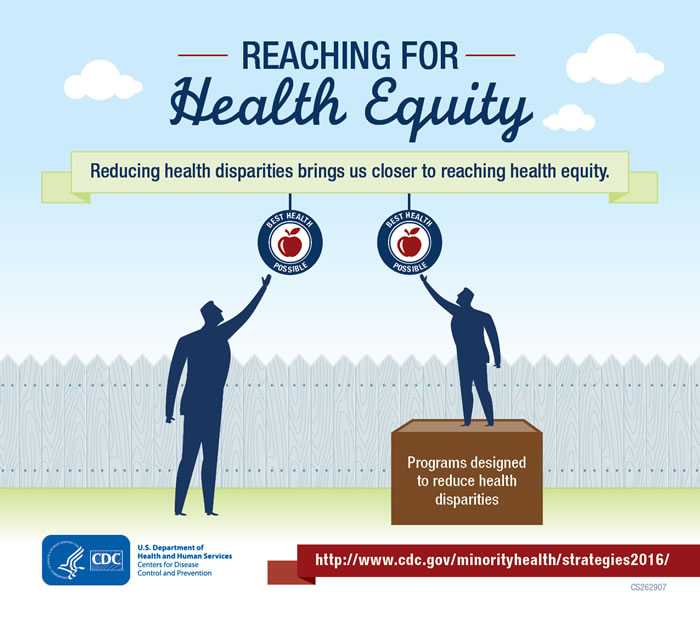Strategies for Reducing Health Disparities
Selected CDC-Sponsored Interventions, United States, 2016
Successful Interventions to Reduce Health Disparities
A major goal of public health is to reduce health disparities. The programs described in the MMWR Supplement, Strategies for Reducing Health Disparities—Selected CDC-Sponsored Interventions, United States, 2016, are examples of CDC-sponsored initiatives that address health disparities with the goal of advancing health equity.
What is Health Equity?
Health equity is when everyone has the opportunity to be as healthy as possible.
What Are Health Disparities?
Health disparities are differences in health outcomes and their causes among groups of people.
Reducing health disparities is a major goal of public health. Achieving health equity, eliminating disparities, and improving the health of all U.S. population groups is one of the goals of Healthy People 2020 .
Strategies for Reducing Health Disparities
Since 2011, CDC Health Disparities and Inequalities Reports (CHDIR) and the Strategies for Reducing Health Disparities reports have highlighted effective public health programs that have reduced disparities.
The 2011 CHDIR was the first CDC Morbidity and Mortality Weekly Report (MMWR) to assess disparities across a wide range of diseases, behavioral risk factors, environmental exposures, social determinants, and health-care access. A second CHDIR was released in 2013 and examined additional topics, in addition to previous topics.
CDC’s Office of Minority Health and Health Equity (OMHHE) published related MMWR reports in 2014 and now again in 2016 to highlight effective public health programs for addressing health disparities.
“Public health professionals can enhance the impact of strategies for reducing health disparities, disseminate and tailor these strategies to reach more communities, and determine how to expand these strategies for even greater impact by rigorously applying lessons learned from these efforts,” said CDC’s Associate Director for Minority Health and Health Equity Leandris Liburd, Ph.D., M.P.H., M.A.
Interventions
The 2016 supplement includes additional interventions to address disparities by race and ethnicity, socioeconomic status, geographic location, disability, and/or sexual orientation across a range of conditions. Interventions described in the supplement include:
-
A report on the Traditional Foods Project . During 2010–2012, American Indian and Alaska Natives adults were about twice as likely to be diagnosed with type 2 diabetes as non-Hispanic whites. This tribally driven effort connects traditional ecological knowledge to health promotion and diabetes prevention.

Traditional Foods Project
- A description of Boston Children’s Hospital’s Community Asthma Initiative. Black and Hispanic children are hospitalized with complications of asthma much more often than are white children. The program demonstrates that interventions by community health workers can significantly reduce hospitalizations in these populations. This effective program has been adapted to other cultural contexts in other cities and states.
- A report on evidence-based programs and strategies to improve levels of screening for colorectal cancer in two states, in Alaska (among Alaska Natives) and in Washington (among racial and ethnic minority and low-income populations).
- A report documenting the reduction of disparities in hepatitis A virus (HAV) infection in the United States following incremental changes in hepatitis A vaccination recommendations to increase coverage for children and persons at high risk for HAV infection.
-
Two reports outlining HIV prevention interventions shown to reduce HIV- and STD-related risk behaviors among Hispanic or Latino men and high-risk men who have sex with men, including substance users.

Living Well with a Disability Program
- A report describing evidenced-based approaches that change policies and structural factors in high risk communities and have the potential to reduce violence .
- An evaluation of the Living Well with a Disability program, which helps people with disabilities learn skills to manage their health by teaching goal-setting and problem solving skills that help remove barriers to maintaining a healthy lifestyle.
These interventions build off of the 2014 supplement which includes additional interventions for reducing health disparities. The 2014 and 2016 supplements emphasize the importance of multidisciplinary collaboration and the need for a community level approach.
Addressing Health Disparities with the Aim of Advancing Health Equity
Implementing evidence-based programs that advance health equity can help ensure that all people have the opportunity for long and healthy lives. Public health professionals and community workers can design and implement strategies for reducing health disparities.
- Page last reviewed: October 3, 2016
- Page last updated: October 3, 2016
- Content source:


 ShareCompartir
ShareCompartir
